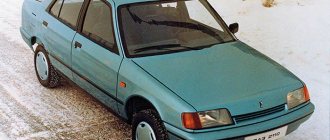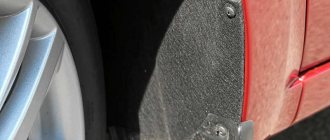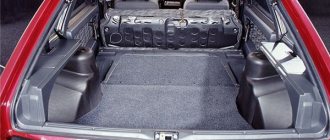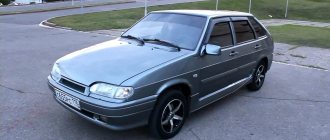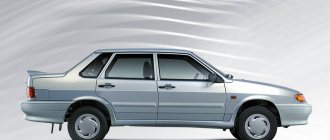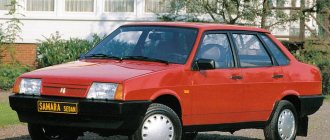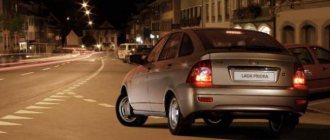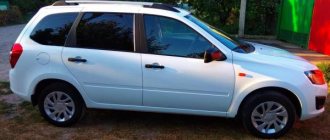VAZ 2110 is a Russian front-wheel drive sedan. In common language - “ten”, which is what the model means. Serial production of the Lada 2110 began in 1996. Initially, the passenger car was produced only as a sedan. Later, the auto giant expanded its lineup with the VAZ 2112 hatchbacks and VAZ 2111 station wagons, as well as the VAZ-21123 coupe.
The 110 model was first demonstrated to then Russian President Boris Yeltsin during a visit to the Volzhsky Automobile Plant in 1992. But the economic crisis prevented the car from quickly being put into mass production.
The appearance of the new model led to many innovations noticed by domestic drivers. For them, the “ten” has become almost a foreign car. Production of the “ten” ended in 2007, and it was replaced by a new model – Lada Priora. The entire Lada model range.
Car history
In addition to the fact that the body of the Lada of the tenth family had smooth lines and was not at all similar to the body of the already boring “99th” model, the 110th model was able to introduce an abundance of new elements that had not previously been seen on vehicles produced by the Volzhsky Automobile Plant. Among the innovations are the presence of an adjustable steering wheel, glued windows, gas hood supports and air conditioning.
After they began installing a sixteen-valve power unit on the VAZ-2110, it became clear to everyone that “it’s better not to joke with Tazami,” since the car could even leave some foreign cars behind. The “Ten” was produced with three versions of equipment: standard, norm and luxury. Despite the stoppage of production of the VAZ-2110 in the Russian Federation, the model is still produced in Ukraine today as the Bogdan 2110.
Work on the design of the dozen began back in 1983. The very first car of this class was supposed to be a sedan with a rear-wheel drive layout. But the developments were never able to reach their own finish line. A little later, the company decided to start developing a vehicle on the VAZ-2108 platform.
However, the cost of this machine was exorbitant, so the developers decided to freeze this project as well. Over time, all the developments resulted in the VAZ-21099 car. At the first time of production, the car came with a carburetor power system, and after 2000 they decided to install distributor fuel injection (injector).
Noise insulation
Do you want to tune the VAZ 2110 yourself? Then you can improve the sound insulation of the cabin. Finding high-quality material for insulating a car is a difficult task, but the future result of your work directly depends on it. Do not forget to prepare all the necessary tools before taking the first steps to create soundproof structures.
It is best to do this work not in the winter, but in the warm season, for example, in spring or summer. And most importantly, free yourself the whole day and devote it to your car. Of course, choose a material that does not get wet. Today, car enthusiasts for tuning 2110 distinguish five types of material that absorb noise quite well:
- to reduce vibration;
- to reduce noise from outside;
- for sound isolation;
- thermal insulation material;
- material that prevents squeaking.
You need to remove the clamps or screws to dismantle the casing. Ultimately, only the metal frame should remain. Remember that the car body is treated with a special solution that minimizes the risk of corrosion. Experts recommend removing this layer. You don’t have to worry, the metal won’t start to rot, since the soundproofing material for the casing will not allow moisture to pass through to the frame of the car.
Exterior
At the time of its release, the VAZ-2110 had a modern look, but at the same time, it became the subject of criticism and discussion among automotive experts. Many people think, looking at some elements, that the design of the car is unattractive. The most problematic area of the design is the rear wing.
The rear of the VAZ, when viewed in profile, seems too heavy. Although, if we compare it with the VAZ 21099, the new model has noticeably improved aerodynamic performance. And as a result of fairly good streamlining, the new VAZ-2110 has become more economical. There are no rectangular shapes here, like on the Samara, and overall the car looks neat.
Now bumpers began to be painted in body color, even in the cheapest modifications. This gave it a characteristic look, especially in those days when it was not always possible to find something like this even in foreign cars. And the most expensive modification - luxury, had additional headlights on the front bumper, and an additional stop light behind the rear window.
All body parts subject to corrosion are galvanized. The body part of the 10th Lada is made more than half of galvanized steel, which in itself increases anti-corrosion resistance.
However, even when purchasing a galvanized VAZ model, you won’t have to rest on your laurels, because those who did not do the anti-corrosion treatment could notice rust on the bottom of the car. Therefore, there is only one conclusion - anticorrosive should be done, regardless of galvanized steel.
Starting with the “norm” configuration, metallic paint is provided, and already in the “Lux” version the VAZ-2110 comes with fourteen-inch alloy wheels. Thanks to the glued glass, body rigidity increases, which is undoubtedly a plus, however, the gaps between body panels in some places can reach 7 millimeters.
If we talk about the door handles, they are made for a lower grip, and this in turn indicates that the vehicle was developed a long time ago. The lock cylinder, which is mounted separately from the handle itself, indicates that the Volzhsky Automobile Plant sedan is budget-friendly.
The appearance of the new model was clearly different from the already familiar “chisel shape” of the cars produced by the Volzhsky Automobile Plant. By reducing the drag coefficient, it was possible to reduce fuel consumption.
The dimensions of the car have become larger in length, height and width, and the track has also been increased along with the base. There was also an increase in mass. Speaking of the latter, it is worth noting that the increase in weight allowed the “ten” to look more respectable, which raised it half a step higher in the table of ranks.
Because of this, changes had to be made to the “running”, although the most important decisions were left the same. Looking at its appearance, you notice that the “brainchild” of domestic automobile production has become heavier and duller. Although, if you evaluate each element, then everything is at its own level.
There are licked surfaces, powerful bumpers painted in body color, and a cute, albeit overly plump, “butt.” However, if you put all this together, then for unknown reasons it does not add up. The characteristic “chisel” grin that was on previous VAZ models is, fortunately, not to be found here.
The front glass of the car is glued in, which indicates the absence of a standard seal. The windshield wiper arm now has an aerodynamic clamp. If we talk about the luggage compartment (which includes the VAZ 2111), the opening has become wider and the loading height has become lower.
Replacement of VAZ-2110 seats
As a rule, the seats are the first place tuning begins. , to put it mildly, do not create a feeling of comfort. And if you are also a fan of fast driving, then you definitely need sports seats. Seat tuning options:
- The most budget option is to remove and modify the installed seats. You can completely remove the trim, replace the inserts, order a new cover from a sewing workshop and install updated “seats”.
- The second option is to install new seats to replace the old ones. At the moment, there are many non-original replacements for factory seats. An even better option would be to buy seats from some damaged foreign car that is being sold for spare parts - but in this case, you will most likely have to redo the fastenings.
Among other things, you can install electric drives and heated seats, which will certainly increase driving comfort.
Interior
When starting to create the interior, the designers took into account some of the shortcomings of previous models and corrected them. Now the driver sits behind the wheel with his legs extended, and not as before, with his legs bent. The steering wheel itself has also changed its appearance, it has become much more beautiful. It has two points of support for the hands with a pillow, and it no longer blocks the visibility of the instruments. The designers have used soft plastic in the dashboard, which looks beautiful and feels good to the touch.
Thanks to this, the likelihood of any noise and squeaks is reduced. In new models, all large mechanical buttons are located on the sides of the dashboard. Climate control is intuitive.
The steering column has the ability to adjust the angle of vertical tilt and has a hydraulic booster. But, despite the updated steering wheel, its rim itself seems too thin to most. The rear seats are quite comfortable, but for three passengers it will already be a bit cramped. The luggage compartment has a volume of 480 liters.
The “Norma” package has front electric windows (it doesn’t matter whether there is a servo drive or not, they do not fully lower into the door), velor upholstery for seats and doors, as well as headrests on the rear sofa. The most expensive “Lux” configuration already has an on-board computer, heated rear-view mirrors and heated seats installed in the front.
The keys installed on the sides of the instrument panel make it impossible to forget that the car began to be designed back in the 1980s. Fuses and relays for the most important options of the car are located inside the car, on the left side under the steering wheel, which is very convenient.
In the famous “Samara” everything was not so convenient. We thought about loading narrow, long things - for this, the middle back of the rear sofa can be fully reclined, and the backs of the rear seats can also be reclined, but at a smaller angle.
Despite the still fairly limited space inside the car, updates to the front fascia and other elements have had a positive impact on the ergonomics of the cabin, which in turn has encouraged many consumers to buy the 2110.
The outside door handle is much better. The tongue from the famous “eight” disappeared, and now the door began to open by simply moving the lever up. Speaking about the doorway, it is worth saying that it has become quite convenient based on the width, but it is too small in height. Not to say that this will interfere, but the lack of headroom is noticeable.
However, the door itself no longer raises any complaints, partly thanks to the sharp upper corner. People of average height have no reason to be afraid, but those who are a little taller should be careful, as they can easily run into him.
In addition, the designers limited the opening angle of the door, which has only one intermediate fixed position. I was pleased that the threshold, which in 2108 was always covered with a layer of dirt in bad weather, now, thanks to the design features, always remains clean.
This point is very important, since when getting into a car you can easily get your clothes dirty if their edges touch the threshold. The driver is presented with a different dashboard, on which there is no longer the “oak” molded plastic - now the panel is made of soft elements reminiscent of the materials used in the VAZ “classic”.
Almost everywhere has become a little more comfortable thanks to the new upholstery of the chairs and the fleecy ceiling. Only the door trim remained molded, however, and it, in turn, became of higher quality.
Some nice touches include height-adjustable seat belts and door locking with central locking. The driver's seat has become more comfortable. The pillow and backrest were increased in width and began to distribute the load better.
You can no longer find that cushion in the lumbar region that bothers drivers, which was on the “eights”. Of course, there was no lateral support before and there is none now. The chair is still adjustable in only two positions, and the adjustments are still mechanical.
The gearshift lever of the VAZ 2110 was lengthened, which may be explained by the desire to reduce the effort when changing gears. The most important sensors - the speedometer and tachometer - now occupied the required space in the central part of the dashboard, and the direction indicators began to be placed on the sides. The center console has acquired indicators for the on-board control system.
Specifications
Power unit
The first VAZ-2110 was equipped with an engine with a carburetor and “automatic choke” without the use of a choke lever, which is present in conventional types of carburetor.
The VAZ 2110 engine had a volume of 1.5 liters and a power of 69 hp. pp., which contributed to economical fuel consumption - approximately 7.5 liters per 100 km. A little later, a 1.5-liter injection 16-valve engine debuted, developing 94 horses. It had a DOHC type gas distribution mechanism.
This engine reached the speed mark of 100 km/h in 12.5 seconds, and the maximum speed had already reached 185 kilometers per hour. The technical equipment of the Lada-2110, which had a sixteen-valve engine, looked quite decent compared to inexpensive foreign cars of those years. The last engine update took place in 2004 - then the volume was increased by 100 cubic cm.
The dynamic component of the 69-horsepower engine is unlikely to impress even the driver of the 2106, however, reduced fuel consumption by 12 percent compared to the 99th often lured buyers. The maximum speed with such an engine is about 162 kilometers per hour.
Also, after a while, the injection 8-valve engine 21102 was produced, the power of which was already 78 horses. The first hundred was reached in 14 seconds, and the maximum speed was 170 kilometers per hour.
Despite the more modest power in terms of technical components, when compared with 1.5-liter engines, the new engines boasted more increased torque. More importantly, the 1.6 16v valves did not bend when the timing belt broke, as often happened with 1.5 16v power units.
In the injection version of the engine, injectors very often fail, but you can repair them yourself or have them repaired by specialists. This video explains well how to clean and rinse the injectors yourself.
But very often when you do it yourself, you can make a lot of mistakes and break even a very working nozzle. Therefore, we advise you to contact specialists who can repair the injectors very quickly and efficiently and even with a guarantee. Why do we recommend the “injector repair” company - because they can even undertake such repairs that everyone refuses, they work throughout Russia and the CIS countries, they have direct supplies of spare parts from manufacturers, and there is express delivery.
In addition to the indicated engines, in the Russian Federation you can find the “Ten” with a two-liter Opell X20XEV power unit, which a little earlier was installed on the Opel Vectra A in one of the most powerful versions. Having such a powerful engine on board, the VAZ-2110 reached the first hundred in just 9.5 seconds, and the maximum speed limit rested at 205 km/h.
Transmission
The VAZ-2110 gearbox is represented by a five-speed manual gearbox with synchronizers in all main gears. The main gear is cylindrical, helical. The differential is conical, two-satellite. The clutch is single-disc, dry, diaphragm.
The car is perfectly repairable, and parts for it are not as difficult to find as for other cars. It’s not for nothing that many people recommend the VAZ-2110 as their first car.
Suspension
The front suspension is independent, with telescopic hydraulic shock absorbers, coil springs, lower wishbones with braces and a stabilizer bar.
The rear suspension consists of levers aggressively attached to the transverse support, coil springs that act as a spring element, as well as double-acting telescopic shock absorbers.
Steering
Installation of a hydraulic power steering wheel is provided. The steering mechanism is rack and pinion.
Brake system
All models of the VAZ-2110 are equipped with disc brakes in front, which on the latest version are also ventilated.
Drum brakes were installed on the rear wheels. Engine modifications Lada 110
| Modification | engine's type | Engine capacity | Revolutions | Transmission | Acceleration up to 100 km/h, sec. | Maximum speed km/h |
| VAZ-2110 1.5 | Petrol | 1499 | 5600 | Mechanical 5st. | 14 | 165 |
| VAZ-21101 1.6i | Petrol | 1596 | 5200 | Mechanical 5st. | 13.5 | 170 |
| VAZ-21102 1.5i | Petrol | 1499 | 5400 | Mechanical 5st. | 14 | 170 |
| VAZ-21103 1.5i | Petrol | 1499 | 5600 | Mechanical 5st. | 12.5 | 185 |
| VAZ-21104 1.6i | Petrol | 1596 | 5000 | Mechanical 5st. | 12 | 180 |
| VAZ-21106 2.0i | Petrol | 1998 | 6000 | Mechanical 5st. | 10.5 | 205 |
| VAZ-21108 1.5i | Petrol | 1499 | 5600 | Mechanical 5st. | 13 | 170 |
Safety
The Russian VAZ-2110 car was also crash tested. The result of the checks carried out in Togliatti turned out to be quite good, when compared with Volga, which, out of the available 16 points, was able to get only a meager 2.
After the frontal impact, the front driver's door was in place, and there was not even a single crease on it, and the windshield pillar was only slightly bent. However, the front door did not open due to the fact that she had propped the back door open. This is not a hopeless option, because it is possible to leave the car using the right door.
But what happens to the mannequins? The sensors that were installed on them did not show any life-threatening overloads! Despite the fact that the driver roughly hit the steering wheel and the dashboard, and the passenger sitting next to him hit the front panel, the head injury rate does not exceed the safe limit - 650 units.
This makes it possible to conclude that the probability of getting a head injury in people who are wearing a seat belt is less than 5%. The important advantages of the sedan were confirmed - the strong power structure of the interior. The conclusion is the following - before soft-boiled, but the interior is intact. This was achieved thanks to safety bars that were welded into the front doors. The material of the beams is not light planks, but steel pipes.
The seat slides were also able to withstand the collision, again not on their own, but thanks to the modernized profiles of the retainer teeth. A small load when the dummy's head collides with the steering wheel was achieved because VAZ made it injury-proof.
The corners of the visor were rounded, and the front panel was made of soft plastic. But there were obvious large overloads on the chest from the seat belts, so the calibrated spring was compressed by 0.40 cm, and in the chest of the passenger sitting next to it by 0.45 cm.
This is partly due to the lack of an airbag, which would soften the result of a sudden and rough stop of the car. So, the load exceeds 800 kg.
On the 10, the steering wheel was shifted slightly back and up (0.95 and 0.45 cm, respectively). Moreover, the steering wheel moved to the right by 1.10 cm, and this is already exceeding the qualifying EuroCAP lateral movement limit.
Regarding the legs, there is a great danger of damaging them. For example, the right leg bears an impact of 730 kilograms. Even the pedals exceeded the permissible threshold - they went back by 205 mm, and according to European standards, a pedal offset of more than 200 mm is already a critical indicator.
Based on the results of calculations and summing up the results, the VAZ-2110 scored 4 points, which is twice as high as the Volga 3110, and the same as Svyatogor. If we talk about what the top ten lacks, these are modern seat belts, airbags, body modifications, changes to the lower part of the front panel and other pedals.
Crash test
Modifications
- VAZ-21100 - eight-valve carburetor, the volume of which is 1.5 liters (produced from 1996-2000);
- VAZ-21101 - eight-valve, the volume of which is 1.6 liters;
- VAZ-21102 – eight-valve, volume 1.5 liters;
- VAZ-21103 – sixteen-valve engine, the volume of which is 1.5 liters;
- VAZ-21104 - sixteen-valve power unit, volume 1.6 liters;
- VAZ-21106 – Engine from Opel GTI 2.0 16V – 2.0-liter sixteen-valve engine, developing 150 horsepower and capable of reaching a top speed of 205 km/h. The VAZ 21106 reaches the initial hundred kilometers per hour in 9.5 seconds;
- VAZ-21106s – created on the VAZ-21106 platform. The technical details are the same as for the VAZ 21106. It has the following modification: power steering, a unique interior, an electric sunroof, fog lights and a disc brake system, which was installed not only on the front wheels, but also on the rear;
- VAZ-21107 is a car with a sixteen-valve two-liter Opel engine, which is designed on the 21106 platform. This model was tuned for a sporty driving style, championships and rallies;
- VAZ-21108 - “Premier” - a version of the Russian sedan, which was slightly lengthened;
- VAZ-21103;
- VAZ-21109 – “Consul” is a four-seater limousine with an engine capacity of 1.5 liters. It reaches 5 meters in length;
- VAZ-2110-91 – “Rotor-Sport”. Production started in 1996 and ended in 2004. A 1.3-liter rotary piston power unit was used. This type of car is the fastest among its “family”. The maximum speed reaches 240 km/h. Reaches the first hundred in just 6 seconds. The car is tuned for circuit racing.
Engine modifications
The VAZ 2110 was produced only with gasoline carburetor and injection engines, which were combined with a 5-speed manual transmission. There were several of them, we will list just a few of them:
| Volume, l | Power, hp | Number of valves | Maximum power, km/h |
| 1,5 | 78 | 8 | 176 |
| 1,6 | 81 | 8 | 176 |
| 1,5 | 93 | 16 | 180 |
| 1,6 | 89 | 16 | 180 |
| 1,6 | 81 | 8 | 177 |
| 1,8 | 98 | 16 | 185 |
AvtoVAZ also produced experimental models: a sports ten with an Opel C20XE engine with a displacement of 2.0 liters and a ten with a rotary piston power plant. The latter, by the way, helped win many autocross competitions during the 90s. Cars with rotary engines did not make it into large-scale production, because It turned out that this modification has an extremely small resource for everyday use.
Options and prices
Today 2110 is no longer produced. The price on the secondary market varies from $3,000 (carburetor version) to $5,000 with an injector and a more decent appearance. The factory provided three modifications: standard, norm and luxury. The last of them was equipped with 14-inch wheels, an on-board computer, heated front seats, a spoiler and fog lights. In its standard configuration, the Lada 110 was almost empty.
However, after 2005, the standard modification improved slightly - now an electronic engine control system and an on-board computer were installed on the car. Moreover, for an additional fee, the car was equipped with a power steering wheel and electric windows.
The steering column could be customized. There were also ventilated brake discs, an immobilizer and air conditioning. In the production of body elements, only galvanized metal was used.
The car from Togliatti was many times superior to other VAZ cars. For those drivers who love speed, they have developed a ten sports class, however, it is already in a different price category.
It is clear that the VAZ’s interior is inferior in comfort to many foreign cars, but it does not look ascetic. Everything looks harmonious and there is ergonomics, which can be improved if necessary. The seats are quite comfortable and have headrests. The ride of the car has become softer and more stable. Alloy wheels were added.
Installation of electronic seats
Another way to carry out interior modernization work is to install electrically adjustable seats. You can install the electric mechanism yourself quite quickly, the procedure will not lead to large financial costs. The work can be carried out for all VAZ cars with front-wheel drive.
The modernization work looks like this:
- First you need to select the necessary parts. To change the seats, you will need a power window, a 10A fuse, buttons for adjusting the position of the backrest and a sufficient number of wires to transfer voltage from the source to the installed motor.
- You can tune the interior of a VAZ 2110 yourself: first, we disassemble the window regulator: gearbox, iron disk - these elements are necessary in order to rotate the entire mechanism being created.
- The design should be slightly changed, for which a hole measuring 14 by 10 millimeters is created.
- Next, we install the entire structure on the seat. In this case, the metal part of the mechanism should be directed towards the seat. The metal part is modified by creating a 13 mm hole in it. The metal bolt that is initially present must be removed.
- In order to eliminate the possibility of damage to the mechanism, it is worth protecting it with a special casing. It can be made from plastic.
- The buttons can be placed in any most convenient place. As a rule, the button block is moved to the central dashboard near the seats. The choice of location for the block of buttons should be taken seriously, since if they are poorly positioned, a lot of inconvenience will be created.
The above work requires the skills to connect the energy consumer to its sources. Be sure to include a fuse in the circuit, which will eliminate the possibility of the motor burning out.
Driver reviews
Most drivers who have ever owned or continue to use a VAZ-2110 to this day say that the car is inexpensive to operate and repair, has good front-wheel drive, starts up despite low temperatures, and is also the best car for a beginner. Also, the domestic vehicle turned out to be quite economical and simple.
However, at the same time, many car enthusiasts do not like the low seating position, poor-quality assembly, the need to constantly monitor the timing belt, the creaking sounds of the front plastic panel, low comfort, frequent breakdowns, small internal dimensions of the VAZ-2110, and so on.
Among the domestic automobile industry, the VAZ-2110 is a pretty good model, but until 2007, because it was after this year that the Volzhsky Automobile Plant began to produce a more improved car.
Is it worth taking?
I would like to assure potential buyers that there are worthy examples that are ready to carry their guests in comfort. But let's be honest: there are no such cars among dozens. And this is not because there is “special treatment” for domestic models, but because the car is simply outdated. The metal is outdated, the technologies used in it are outdated, the very philosophy of the former legend is outdated. Of course, in the 90s, a ten was considered a symbol of prosperity and not everyone could buy it. Now it is available at an extremely low cost, but parting with money for such a vehicle is not advisable.
Lada 110 Premier (21108) 1998–2007
If you nevertheless take a desperate step and decide to buy a VAZ 2110, you should remember the following things:
- cars 2002-2003 were produced with a large number of defects, so they are not worth considering. Among the most common “sores”: gearbox jamming, depressurization of the cooling system, problems with the cylinder head.
- dozens with original mileage up to 100 thousand km are a rarity. But there are more than enough such copies on ad sites and car markets. The paradox is easy to explain: it is possible to force a buyer to purchase a 25-year-old model at a high price only by convincing him of “careful and gentle operation.” The mileage history needs to be assessed soberly: even if you drove a car 100 km a week, then in 25 years your mileage would be 130 thousand kilometers, but not 100.
- When inspecting a car, pay special attention to the sills, wheel arches, and the bottom of the doors: through corrosion is a problem for all dozens. And if the owners did not process the body in a timely manner, the car will “crawl” in these very places. If you are going to buy a car for family use, avoid rusty vehicles: they can play a cruel joke in an accident.
- Don’t be lazy to order a car history on special websites. Dozens are actively used in taxis, they are bought by inexperienced drivers, so eliminate the risk of purchasing a damaged vehicle.
- The safety level of the VAZ 2110 is extremely low: it does not have airbags or ABS. In the event of a side impact, body stability will not be enough to protect passengers. Keep this in mind when choosing a top ten for personal purposes.
Advantages and disadvantages
Pros of the car
- Available service;
- Availability of spare parts;
- Possibility of repair “in the garage”;
- Front-wheel drive;
- 16-valve injection engine;
- Improved security system;
- Low fuel consumption;
- Suspension adapted to poor-quality road surfaces;
- There is a hydraulic power steering wheel;
- The steering column can be adjusted;
- Air conditioning can be installed;
- Improved front panel.
Cons of the car
- Corrosion of metal;
- Small resource of some spare parts;
- Build quality;
- Unbalanced operation of the stove;
- Low sound insulation of the cabin;
- Constant monitoring of the timing belt;
- Equipment.
- There is little free space inside the car;
- It will be uncomfortable for three adult passengers to sit in the back.
Let's sum it up
The VAZ-2110 model with a modern interior and exterior design has shown that it is not afraid of the Russian climate, and it is well suited to our roads, fitting into city traffic. The car has a roomy trunk, a pleasant interior, a fast engine and low fuel consumption.
The VAZ-2110 vehicle has especially many advantages over its direct predecessor, the 99th model. Here a hydraulic power steering wheel appeared, as well as its adjustments, which could only be dreamed of before.
The appearance no longer had such a “jagged” appearance; now it was a more or less pleasant car with improved aerodynamic resistance. The inside of the car has also become much better and nicer, which is worth the new front panel. But when it comes to quality, domestic car manufacturers still have a long way to go.
Although, if we take the low cost of the sedan, then it was fully justified, because the consumption was not so high, the power unit was injection and quite strong, and the maintainability of the car was excellent. To this day, you can quite often see on the roads of the Russian Federation, and not only, the VAZ-2110, which continues to serve its owners.
We advise you to read the article: History of AvtoVAZ - LADA cars
Lada 110 photos
Read further:
Amazing hatchback Lada X-Ray Cross: price and specifications in Russia
The interior of the Lada Vesta is not impressive
Porsche 928
Dodge Viper ACR
Buick Electra 225 Convertible

